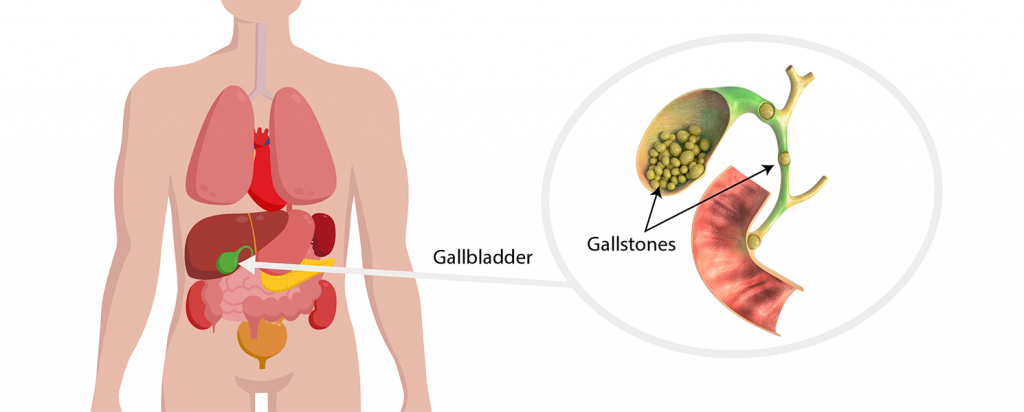Gallstones are concretions and form in the gallbladder and occasionally in the bile ducts leading out of the gallbladder, from the constituents of bile. They can vary in size and number from sand or sludge through to single large stones several centimetres in size. Up to 80% of adults will have gallstones present on investigation (usually an ultrasound). The presence or absence of symptoms in association with the gallstones is important in defining management

GALLSTONES
Asymptomatic Gallstones
- Many patients with gallstones have no symptoms and the gallstones are found incidentally on investigations carried out for other purposes.
- For the patient who has gallstones but no symptoms there is a 20% chance of developing symptoms over 20 years and a 10% chance that those symptoms will be significant and require hospital treatment.
- Overall asymptomatic gallstones mostly require monitoring rather than surgery.
Symptomatic Gallstones
- Approximately 20% of patients with gallstones have symptoms. Most commonly these are abdominal/chest or shoulder pain, nausea, indigestion, fevers and occasionally jaundice (abnormal yellow pigmentation of the skin and eyes).
- Common triggers for gallstone related pain are fatty or oily foods
- Classically the pain begins several hours after eating in the upper right part of the abdomen, patients tend to be restless and unable to find a comfortable position, the pain may spread to the back, shoulders or chest and be associated with nausea and vomiting
- Several conditions cause gallstone related pain and relate to the position of the gallstone within the gallbladder
- Biliary colic: The gallstone causes a temporary blockage of the gallbladder, stopping it from emptying. Usually pain is temporary as the gallstone moves away from the point of blockage
- Cholecystitis: The gallstone remains blocking the gallbladder and a bacterial infection develops in the obstructed gallbladder. Usually the symptoms are longer lasting than biliary colic and maybe associated with fevers
- Choledocholithiasis: The gallstone has passed from the gallbladder and is causing a blockage of the ducts that drain the gallbladder. Generally, pain in this condition is accompanied by jaundice and if there is an associated infection (cholangitis) fever and chills are also present
- Pancreatitis: The gallstone causes a temporary blockage of the lower end of the bile duct where it empties into the bowel. This can also block drainage of the pancreas gland causing inflammation. Pain in this condition tends to be constant and can also be felt in the back.
Treatment of Gallstones
While many patients have gallstones throughout their lives and experience no symptoms, of the patients who do develop symptoms these tend to be long lasting and increase in severity over time. Consequently for patients with symptomatic gallstones surgical treatment is recommended. This involves keyhole surgery to remove the gallbladder (laparoscopic cholecystectomy) with a intraoperative x ray (cholangiogram) to check that no gallstones have moved from the gallbladder to the other bile ducts. Overall approximately 10,000 cholecystectomies are performed in Aotearoa New Zealand annually.
Common questions regarding laparoscopic cholecystectomy
- How long does the procedure take? Approximately 45 minutes.
- Will I be able to eat normally afterward? The aim of the surgery is to allow patients to resume a normal diet and lifestyle. Generally, patients prefer light meals for 2 weeks after any sort of surgery and we anticipate patients will have resumed a normal diet by one-month post procedure.
- Can the gallstones be removed and the gallbladder left? Yes but most patients develop new gallstones within 2 years. In addition, gallbladders in patients with symptomatic gallstones tend to work poorly with inefficient emptying of bile in response to a meal.
- When can I go back to work? Most patients with a non-physical occupation return to work within 5-7 days and after 10-14 days for an occupation requiring physical activity.
- When do I need to get my stitches removed? Harbour surgeons use dissolving stitches placed under the skin so there is no need for stitch removal.
- When can I return to physical activity and exercise? Walking can start on day one post procedure, running and resistance work in the gym at between 7-14 days depending on how you feel.
The content is to be used as a guide only. Always consult your specialist to determine information relevant to you and your circumstances.
